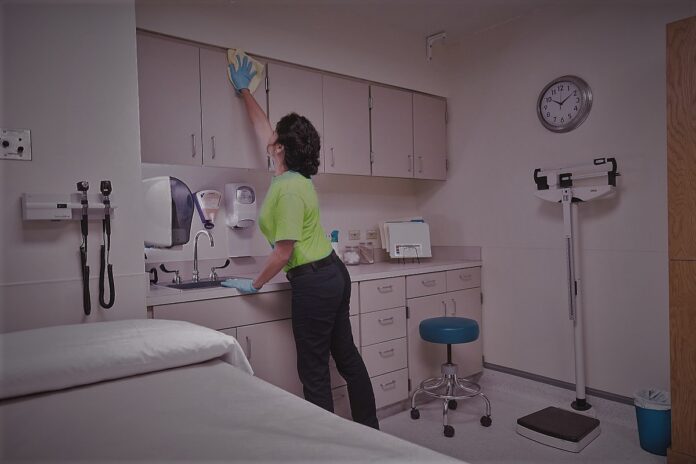Medical offices stand at the crossroads of healthcare delivery, acting as critical gateways for countless patients seeking medical attention. Within these walls, cleanliness becomes more than a visual appeal—it’s an unspoken commitment to patient safety and care.
Beyond preventing potential health hazards and reducing infection risks, a spotless environment emanates a message of professionalism, reinforcing a bond of trust with those who walk through the door. An immaculate medical office ensures that the patient’s first impression is of meticulous attention to detail and uncompromised care standards. Given the stakes, many medical facilities are now turning to a commercial cleaning company who specialises in ensuring health standards are met.
This article seeks to highlight the indispensable role of these professionals and provide a roadmap for medical offices to achieve and maintain an unparalleled standard of hygiene.
Why Hire Professional Cleaners?
Medical settings are complex ecosystems, replete with a mix of everyday dirt and potentially dangerous pathogens. While routine cleaning maintains order, it may fall short in addressing specialised needs of such an environment. Here’s where the expertise of professional cleaners proves invaluable.
These experts come equipped with training tailored for medical scenarios – understanding the intricacies of biomedical waste disposal, mastering the art of disinfection, and employing advanced equipment designed for thorough cleaning. Their rigorous methods ensure adherence to stringent healthcare cleanliness regulations, dramatically curtailing the risks associated with cross-contamination.
Moreover, their efforts underline the dual objective of ensuring safety while fostering a serene environment for both patients and staff. The result? A facility that doesn’t just appear clean, but is sanitised to the highest standards, exuding an ambiance of genuine care and utmost professionalism.
20 Steps To Keep A Medical Office Clean
1. Establish a Cleaning Protocol
Creating a robust protocol is foundational. This blueprint should detail cleaning frequency, target areas, and the tools and solutions required. Such a framework guarantees uniformity and comprehensive cleaning.
2. Use Appropriate Disinfectants
Opt for hospital-grade disinfectants, ensuring a thorough elimination of harmful pathogens that might lurk in medical settings.
3. Focus on High-Touch Areas
Prioritise areas like elevator buttons, door handles, and counters. Regular disinfection, especially during peak hours, curbs the risk of contamination.
4. Proper Waste Disposal
Biohazard waste demands meticulous handling. Ensure segregation, appropriate storage, and disposal as per established health guidelines.
5. Floor Care
Vacuum daily and mop with disinfectants. Given the high footfall, consider engaging professional cleaning services monthly for an in-depth floor cleanse.
6. Patient Rooms/Examination Areas
Given the sensitive nature of examinations, sanitise the space post each appointment, ensuring a hygienic environment for every patient.
7. Regularly Clean Air Vents
With airborne diseases posing significant threats, maintaining clean air vents is non-negotiable. Weekly dusting and sanitization can curtail the spread of airborne pathogens.
8. Restroom Maintenance
Being frequently used, restrooms require stringent cleaning. Focus on fixtures, replenish soaps and sanitizers.
9. Waiting Areas
Clean the seating areas, surfaces, and provide sanitised reading materials. Air purifiers can be invaluable in ensuring a continuous supply of fresh air.
10. Training Staff
Empower your in-house staff with basic cleaning know-how, enabling them to uphold hygiene standards and promptly report anomalies.
11. Use Disposable Barrier Sheets
For examination tables, disposable barriers prevent cross-contamination. Change them between patients, ensuring a fresh surface each time.
12. Schedule Regular Deep Cleaning
Engage specialists for deep cleaning, focusing on areas like upholstery and intricate equipment, guaranteeing a thorough sanitation process.
13. Monitor Cleaning Efficacy
Periodic evaluation of cleaning protocols ensures they remain effective. Adjust based on findings, ensuring consistent cleanliness.
14. Maintain a Sanitized Reception
The reception is the first point of contact. Ensure pens, clipboards, and other tools are sanitized after use. A clean reception sets a reassuring tone for visitors.
15. Equip Rooms with Sanitizers
Place hand sanitizers in strategic locations, encouraging both staff and patients to use them regularly, especially after touching shared surfaces.
16. Sanitize Medical Equipment
Equipment like stethoscopes, BP monitors, and other tools need regular sanitization, given their proximity to patients during examinations.
17. Limit Crowding
While not a direct cleaning strategy, minimizing crowding by spacing appointments can reduce the spread of pathogens, allowing time for effective cleaning between patients.
18. Encourage Feedback
Patients and staff can provide valuable insights into areas needing more attention. Encourage feedback, using it as a tool for improvement.
19. Stay Updated
The medical cleaning landscape evolves rapidly. Stay abreast with the latest in cleaning technology and methodologies, integrating them as needed.
20. Emergency Protocols
In case of sudden outbreaks or other emergencies, have a clear and swift protocol for deep cleaning to decrease risks and restore normalcy at the earliest.
Wrap-up
Medical offices are sanctuaries of health, and their cleanliness is pivotal in upholding this role. It’s more than mere routine; it’s a commitment to patient well-being and trust. Through the outlined practices, facilities can champion unparalleled hygiene standards, ensuring the environment resonates with their core values of care and safety. The healthcare domain, with its elevated stakes, warrants meticulous attention to even the minutest detail.
Therefore, ensuring cleanliness transcends aesthetics—it’s about safeguarding health. So, while a gleaming space is welcoming, ensuring its sanitation is the true hallmark of excellence in healthcare.

| [donate]
| Help keep news FREE for our readersSupporting your local community newspaper/online news outlet is crucial now more than ever. If you believe in independent journalism,then consider making a valuable contribution by making a one-time or monthly donation. We operate in rural areas where providing unbiased news can be challenging. |

















